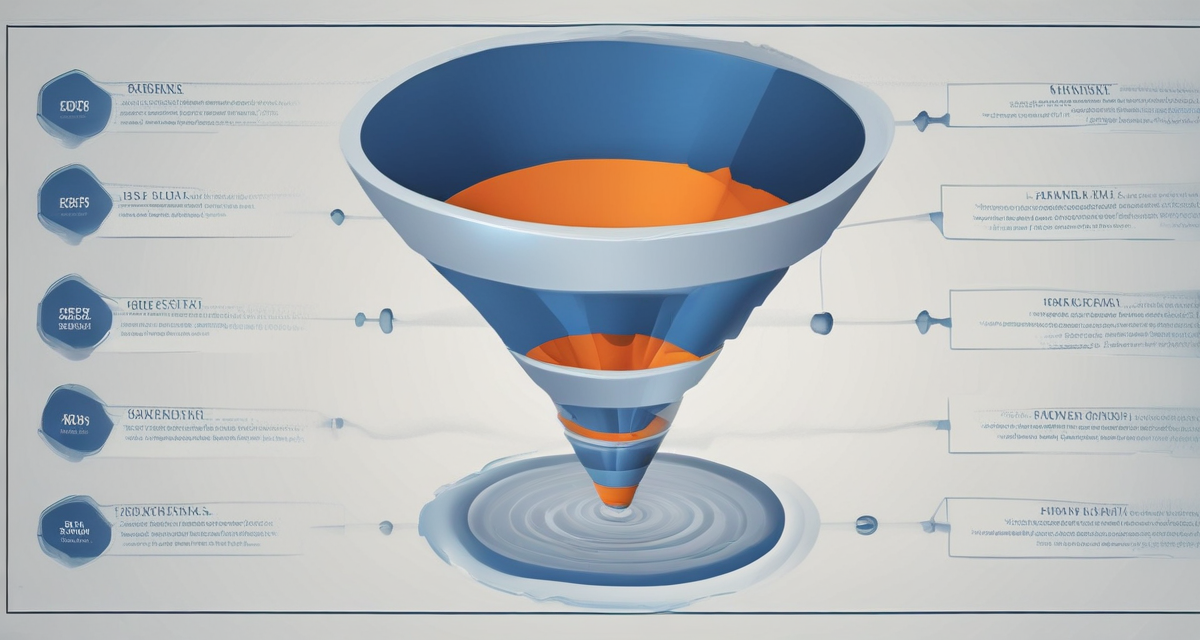The CRO funnel is a step-by-step process potential customers go through before making a purchase.
In this article, you’ll learn how to optimize your CRO funnel to increase conversion rates and enhance customer experience. By focusing on each stage, you can turn potential customers into loyal buyers.
In this article, you will learn:
- Key metrics to track for CRO success
- Effective content strategies to engage users
- How to leverage social media for conversions
Understanding the CRO Funnel
When it comes to optimizing your conversion rate, understanding the CRO funnel is crucial. At its core, a CRO funnel is a step-by-step process that potential customers go through before making a purchase. By optimizing each stage of this funnel, you can significantly increase the likelihood of conversions.
The CRO funnel is a process that potential customers go through before making a purchase.
Stages of the CRO Funnel
The CRO funnel consists of several stages, each with its own set of challenges and opportunities:
- Awareness: This is the first stage where potential customers become aware of your brand or product.
- Interest: At this stage, customers start showing interest in what you offer and engage with your content.
- Consideration: Here, customers evaluate whether your product or service meets their needs.
- Intent: Customers are ready to make a purchase decision and may seek additional information or reassurance.
- Purchase: The final stage where the customer makes a transaction.
Optimizing Each Stage
To optimize each stage of the CRO funnel, you need to tailor your strategies accordingly:
- Awareness: Utilize SEO and content marketing to attract potential customers.
- Interest: Engage users with valuable content and clear calls-to-action.
- Consideration: Provide detailed information, case studies, and reviews to help customers make informed decisions.
- Intent: Offer promotions, discounts, and easy-to-navigate checkout processes.
- Purchase: Ensure a smooth transaction process and excellent customer service.
Examples and Statistics
For instance, companies that focus on optimizing their CRO funnel can see up to a 30% increase in conversions. By understanding and addressing each stage, you can turn casual browsers into loyal customers.
According to a study by Forrester, businesses that excel in CRO have a 1.6 times higher conversion rate compared to those that don’t.
By optimizing your CRO funnel, you’re not just improving your chances of making a sale, but you’re also enhancing the overall customer experience.
Identifying Key Metrics
To optimize your CRO funnel effectively, it’s crucial to identify and track the right metrics. These metrics help you understand where potential customers are dropping off and what actions you can take to improve their journey through the funnel.
Tracking the right metrics in your CRO funnel can significantly boost your conversion rates.

Let’s dive into some of the key metrics you should be focusing on:
1. Conversion Rate
Your conversion rate is the percentage of visitors who complete a desired action. This could be making a purchase, signing up for a newsletter, or filling out a contact form. By monitoring this metric, you can gauge the effectiveness of your funnel and identify areas for improvement.
2. Bounce Rate
Bounce rate measures the percentage of visitors who leave your site after viewing only one page. A high bounce rate may indicate that your landing page isn’t engaging or relevant to your audience. Reducing bounce rate can help keep potential customers in your funnel longer.
3. Average Session Duration
This metric shows how long visitors stay on your site. Longer sessions typically indicate higher engagement and interest in your content. If visitors are spending more time on your site, they’re more likely to move through your funnel.
4. Cart Abandonment Rate
Cart abandonment rate is the percentage of users who add items to their cart but don’t complete the purchase. High cart abandonment rates can highlight issues with the checkout process or indicate that customers need more incentives to complete their purchase.
5. Click-Through Rate (CTR)
CTR measures the percentage of users who click on a specific link or call-to-action (CTA). A higher CTR means your CTAs are compelling and effectively guiding users through your funnel.
6. Customer Lifetime Value (CLV)
CLV predicts the total revenue you can expect from a customer over the entire duration of their relationship with your business. Higher CLV suggests that your funnel is not only converting visitors but also retaining customers for long-term engagement.
By focusing on these key metrics, you can gain valuable insights into your funnel’s performance and make data-driven decisions to optimize it further.
Remember, these metrics are not just numbers; they tell the story of your customer’s journey. Analyzing them will help you create a more effective and enjoyable experience for your visitors.
Effective Content Strategies
Creating effective content is crucial for optimizing your CRO funnel. Well-crafted content can guide potential customers through the funnel stages, ultimately leading them to make a purchase. Let’s dive into some strategies that can make a significant impact.
The right content strategy can transform your CRO funnel and drive higher conversion rates.

First, focus on producing high-quality, relevant content that addresses your audience’s pain points. Blog posts, whitepapers, and case studies are great ways to provide valuable information. Engaging content not only attracts visitors but also keeps them on your site longer, increasing the likelihood of conversions.
Utilize Different Content Types
Don’t stick to just one type of content. Use a mix of:
- Blog posts
- Videos
- Infographics
- Webinars
- Podcasts
This variety ensures that you’re appealing to different preferences and learning styles, making your content more accessible and engaging.
Optimize for Search Engines
SEO is vital for driving organic traffic to your site. Use relevant keywords naturally within your content. For instance, in this article, we’re focusing on ‘CRO funnel optimization.’ Ensure that your content is easily readable and provides value to the reader.
Another tip is to include internal and external links. Internal links keep visitors on your site longer, while external links to authoritative sources boost your content’s credibility.
Leverage User-Generated Content
User-generated content (UGC) like reviews, testimonials, and social media posts can significantly impact your conversion rates. Encourage your customers to share their experiences and showcase this content on your website.
UGC not only builds trust but also provides fresh content for your site, which can improve your SEO.
Personalize Your Content
Personalization is key to connecting with your audience. Use data to segment your audience and tailor content to their specific needs and interests. Personalized content can make your visitors feel valued and understood, increasing the likelihood of conversion.
For example, email marketing campaigns that address the recipient by name and offer tailored recommendations can see higher open and conversion rates.
Regularly Update Your Content
Content needs to be fresh and up-to-date. Regularly review and update your existing content to ensure it remains relevant and valuable. This practice can also improve your site’s SEO, as search engines favor updated content.
Consider using a content calendar to plan and schedule updates. This proactive approach ensures your content stays current and continues to drive conversions.
Leveraging Social Media
Social media is a powerful tool for optimizing your CRO funnel. By strategically using platforms like Facebook, Instagram, LinkedIn, and Twitter, you can reach a broader audience and engage potential customers effectively. The key is to understand where your target audience spends their time and tailor your content accordingly.
Effective use of social media can significantly enhance your CRO funnel by increasing engagement and driving
conversions.

To leverage social media effectively, start by creating a content calendar. This helps ensure consistent posting and keeps your audience engaged. Use a mix of content types, such as blog posts, videos, infographics, and user-generated content, to keep things
interesting.
Utilize Analytics Tools
Analytics tools like Facebook Insights, Twitter Analytics, and LinkedIn Analytics provide valuable data about your audience’s behavior. Use these insights to refine your strategy. For example, if a particular type of post gets more engagement, create more of that content.
Engage with Your Audience
Engagement is crucial. Respond to comments, participate in discussions, and show appreciation for user-generated content. This interaction builds trust and loyalty, which are essential for conversions.
- Respond to comments and messages promptly.
- Host live sessions and Q&A to interact with your audience in real-time.
- Encourage user-generated content by running contests or challenges.
Paid Advertising
Don’t underestimate the power of paid social media advertising. Platforms offer highly targeted ad options that can drive significant traffic to your site. Experiment with different ad formats, such as carousel ads, video ads, and sponsored posts, to see what works best for your audience.
Monitor and Adjust
Finally, always monitor your social media campaigns and adjust as needed. Use A/B testing to compare different strategies and find the most effective approach. Regularly review your analytics to stay updated on what’s working and what’s not.
By leveraging social media effectively, you can enhance your CRO funnel and drive more conversions. Remember, consistency and engagement are key to success.
Measuring Success and Adjusting
After optimizing your CRO funnel, it’s crucial to measure success and make necessary adjustments. This ensures that your strategies are effective and your goals are met.
Start by setting clear objectives. What do you want to achieve? Increased conversions? Higher engagement? Define your targets to measure progress accurately.
Next, regularly review your key metrics. Focus on:
- Conversion Rate: The percentage of visitors who complete a desired action.
- Bounce Rate: The percentage of visitors who leave after viewing one page.
- Average Session Duration: The average time users spend on your site.
- Cart Abandonment Rate: The percentage of users who add items to their cart but don’t complete the purchase.
- Click-Through Rate (CTR): The ratio of users who click on a link to the number of total users who view a page, email, or ad.
- Customer Lifetime Value (CLV): The total revenue expected from a customer throughout their relationship with your business.
Analyze these metrics to identify areas for improvement. For example, a high bounce rate may indicate that your landing page isn’t engaging enough. Similarly, a low conversion rate could mean you need to optimize your calls to action.
Use A/B testing to experiment with different strategies. Try variations of your content, design, and offers to see what works best. This data-driven approach helps you make informed decisions and continuously improve your CRO funnel.
Finally, don’t forget to gather feedback from your customers. Their insights can be invaluable in refining your strategies. Use surveys, reviews, and direct interactions to understand their needs and preferences better.
By regularly measuring success and adjusting your strategies, you can ensure your CRO funnel remains effective and continues to drive conversions.
Ready to boost your conversions? Contact us today to get started!




